
The Asian green bee-eater, also known as little green bee-eater, and green bee-eater in Sri Lanka, is a near passerine bird in the bee-eater family. It is resident but prone to seasonal movements and is found widely distributed across Asia from coastal southern Iran east through the Indian subcontinent to Vietnam. Populations in Africa and the Arabian Peninsula that were formerly assigned to this species are now considered distinct species: the African green bee-eater and the Arabian green bee-eater. They are mainly insect eaters and they are found in grassland, thin scrub and forest often quite far from water. Several regional plumage variations are known and several subspecies have been named.

The brown shrike is a bird in the shrike family that is found mainly in Asia. It is closely related to the red-backed shrike and isabelline shrike. The genus name, Lanius, is derived from the Latin word for "butcher", and some shrikes are also known as "butcher birds" because of their feeding habits. The specific cristatus is Latin for "crested", used in a broader sense than in English. The common English name "shrike" is from Old English scríc, "shriek", referring to the shrill call.

Woodswallows are soft-plumaged, somber-coloured passerine birds in the genus Artamus. The woodswallows are either treated as a subfamily, Artaminae, in an expanded family Artamidae, or as the only genus in that family. The generic name, which in turn gives rise to the family name, is derived from the Ancient Greek artamos, meaning butcher or murder. The name was given due to their perceived similarity to shrikes. A former common name for the group was "swallow-starlings".

The white-breasted woodswallow is a medium-sized passerine bird which breeds from the Andaman Islands east through Indonesia and northern Australia. The name "woodswallow" is a misnomer as they are not closely related to true swallows. Instead, they belong to the family Artamidae, which also includes butcherbirds, currawongs and the Australian magpie.

The Oriental darter is a water bird of tropical South Asia and Southeast Asia. It has a long and slender neck with a straight, pointed bill and, like the cormorant, it hunts for fish while its body is submerged in water. It spears a fish underwater, bringing it above the surface, tossing and juggling it before swallowing the fish head first. The body remains submerged as it swims, and the slender neck alone is visible above the water, which accounts for the colloquial name of snakebird. Like the cormorants, it has wettable feathers and it is often found perched on a rock or branch with its wings held open to dry.

The Indian nightjar is a small nightjar which is a resident breeder in open lands across South Asia and Southeast Asia. Like most nightjars it is crepuscular and is best detected from its characteristic calls at dawn and dusk that have been likened to a stone skipping on a frozen lake - a series of clicks that become shorter and more rapid. They are sometimes spotted on roads when their eyes gleam red in the spotlight of a vehicle. There is considerable plumage variation across its range and can be hard to differentiate from other nightjars in the region especially in the field.

The black-rumped flameback, also known as the lesser golden-backed woodpecker or lesser goldenback, is a woodpecker found widely distributed in the Indian subcontinent. It is one of the few woodpeckers that are seen in urban areas. It has a characteristic rattling-whinnying call and an undulating flight. It is the only golden-backed woodpecker with a black throat and a black rump.

The purple-rumped sunbird is a sunbird endemic to the Indian Subcontinent. Like other sunbirds, they are small in size, feeding mainly on nectar but sometimes take insects, particularly when feeding young. They can hover for short durations but usually perch to lap nectar from flowers. They build a hanging pouch nest made up of cobwebs, lichens and plant material. Males are contrastingly coloured but females are olive above and yellow to buff below. Males are easily distinguished from the purple sunbird by the light coloured underside while females can be told apart from males by their whitish throats.
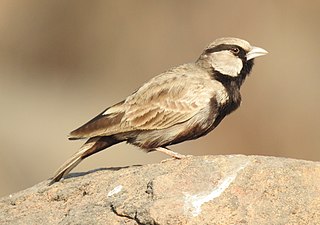
The ashy-crowned sparrow-lark is a small sparrow-sized member of the lark family. It is found in the plains in open land with bare ground, grass and scrub across South Asia. The males are well marked with a contrasting black-and-white face pattern, while females are sandy brown, looking similar to a female sparrow. Males are easily detected during the breeding season by the long descending whistle that accompanies their undulating and dive-bombing flight displays.

The yellow-billed babbler is a member of the family Leiothrichidae endemic to southern India and Sri Lanka. The yellow-billed babbler is a common resident breeding bird in Sri Lanka and southern India. Its habitat is scrub, cultivation and garden land. This species, like most babblers, is not migratory, and has short rounded wings and a weak flight and is usually seen calling and foraging in groups. It is often mistaken for the jungle babbler, whose range overlaps in parts of southern India, although it has a distinctive call and tends to be found in more vegetated habitats. Its name is also confused with Turdoides leucocephala, which is also known as white-headed babbler.

The thick-billed flowerpecker is a tiny bird in the flowerpecker group. They feed predominantly on fruits and are active birds that are mainly seen in the tops of trees in forests. It is a resident bird with a wide distribution across tropical southern Asia from India east to Indonesia and Timor with several populations recognized as subspecies some of which are sometimes treated as full species.

The Indian cuckoo or short-winged cuckoo is a member of the cuckoo order of birds, the Cuculiformes, that is found in the Indian subcontinent and Southeast Asia. It ranges from India, Bangladesh, Bhutan, Nepal and Sri Lanka east to Indonesia and north to China and Russia. It is a solitary and shy bird, found in forests and open woodland at up to 3,600 m (11,800 ft).
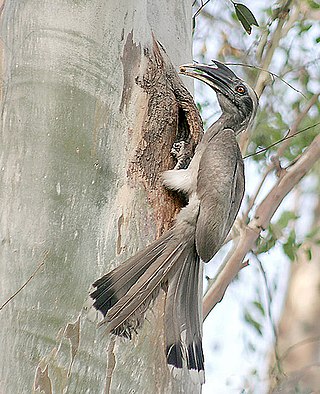
The Indian gray hornbill is a common hornbill found on the Indian subcontinent. It is mostly arboreal and is commonly sighted in pairs. It has grey feathers all over the body with a light grey or dull white belly. The horn is black or dark grey with a casque extending to the point of curvature of the horn. It is one of the few hornbill species found in urban areas in many cities where they are able to make use of large trees in avenues.
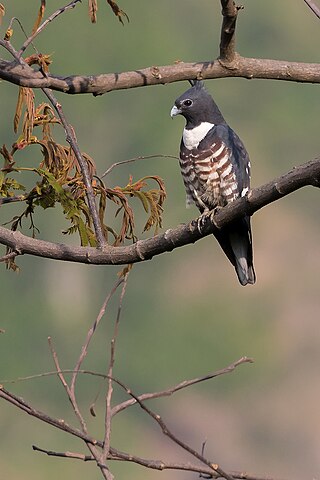
The black baza is a small bird of prey found in the forests of Northeast India, the eastern Himalayas, China and Southeast Asia. Many populations are migratory, including those in the Indian region, which winter in the south of the Peninsula and Sri Lanka. Black bazas have short, stout legs and feet with strong talons, and a prominent crest. They are found in dense forest, often in small groups, and can often be found perched on bare branches of tall trees rising above the forest canopy.
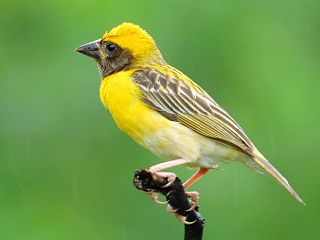
The baya weaver is a weaverbird found across the Indian Subcontinent and Southeast Asia. Flocks of these birds are found in grasslands, cultivated areas, scrub and secondary growth and they are best known for their hanging retort shaped nests woven from leaves. These nest colonies are usually found on thorny trees or palm fronds and the nests are often built near water or hanging over water where predators cannot reach easily. They are widespread and common within their range but are prone to local, seasonal movements mainly in response to rain and food availability.

The common woodshrike is a species of bird found in Asia. It is now usually considered a member of the family Vangidae. It is small and ashy brown with a dark cheek patch and a broad white brow. It is found across Asia mainly in thin forest and scrub habitats where they hunt insects, often joining other insectivorous birds. The form found in Sri Lanka which was treated as a subspecies is now usually considered a separate species, the Sri Lanka woodshrike.

The bank myna is a myna found in the northern parts of South Asia. It is smaller but similar in colouration to the common myna, only differing in having brick-red naked skin behind the eyes instead of yellow. It is greyer on the underside and in this and in the presence of a slight tuft of feathers bears some resemblance to the jungle myna. They are found in flocks on the plains of northern and central India, often within towns and cities. Their range appears to be extending southwards into India. The name is derived from their habit of nesting almost exclusively in the earthen banks of rivers, where they excavate burrows and breed in large colonies.
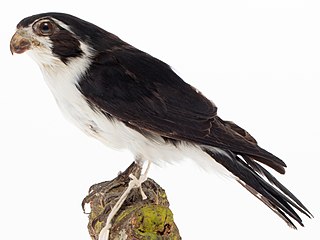
The pied falconet, is a species of bird of prey in the family Falconidae. It is found in Bangladesh, Bhutan, China, Hong Kong, India, Laos, and Vietnam. Its natural habitat is temperate forests.

The ashy minivet is a passerine bird of eastern Asia belonging to the minivet genus Pericrocotus in the cuckooshrike family Campephagidae. While most of the minivets have shades of yellow, orange and red in their plumage, this species has only greys, whites and blacks. The male is distinctive with a white face and black nape although females can be confused with the female of the brown-rumped minivet. They forage in the canopy, often along with other minivets and join mixed-species foraging flocks.

Artamidae is a family of passerine birds found in Australia, the Indo-Pacific region, and Southern Asia. It includes 24 extant species in six genera and three subfamilies: Peltopsinae, Artaminae and Cracticinae. Artamids used to be monotypic, containing only the woodswallows, but it was expanded to include the family Cracticidae in 1994. Some authors, however, still treat the two as separate families. Some species in this family are known for their beautiful song. Their feeding habits vary from nectar sucking (woodswallows) to predation on small birds.
























